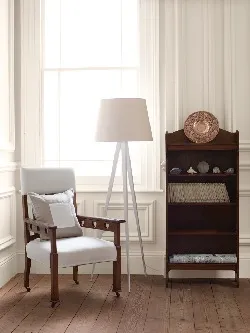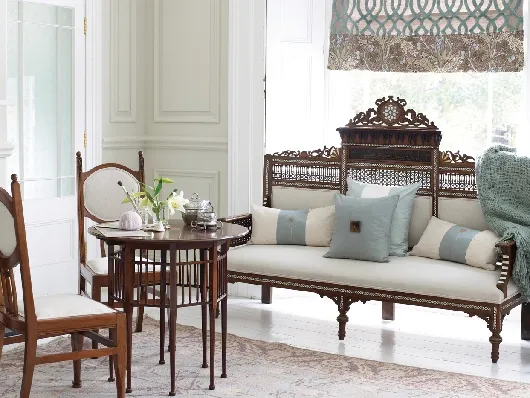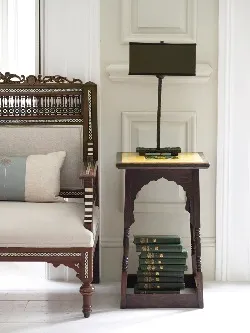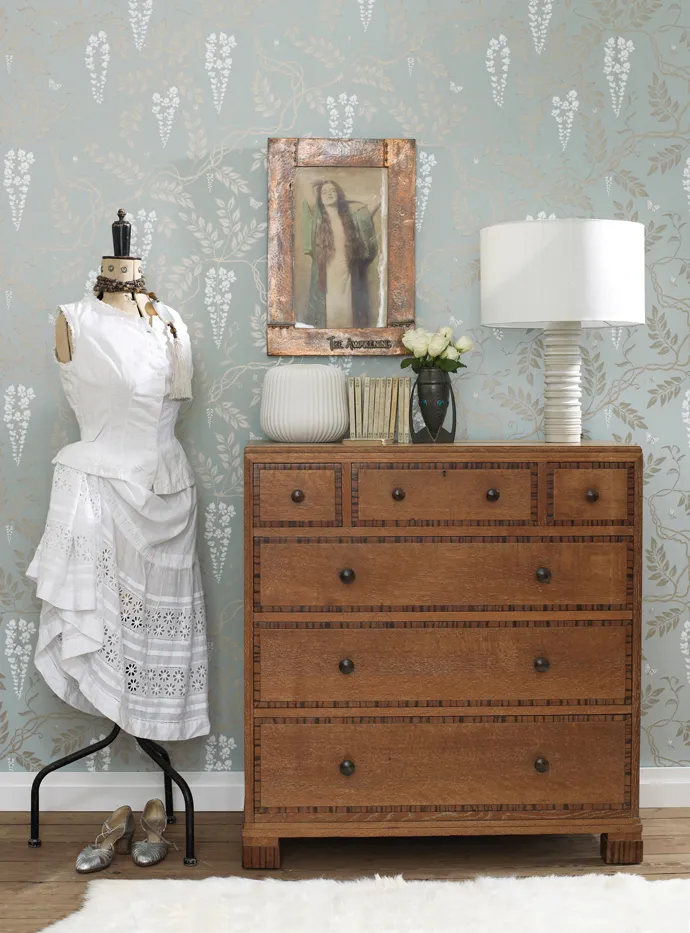Increasingly perturbed by the excesses of capitalism, more and more of us are turning back towards nature and community, handicrafts and organic materials, mirroring the backlash against industrialisation that took place over 100 years ago. In short, we’re embracing the values of the Arts and Crafts era, and loving its artefacts. John Masters, of The Design Gallery in Kent, agrees. ‘The furniture seems so relevant now, so credible – people are really connecting with it.’

In the second half of the 19th century, influential thinkers, inspired by architect-designers such as John Ruskin and William Morris, called for social and aesthetic revolution. They believed the route to social well-being was a move away from the mindless mechanical tasks of contemporary production and a return to the manufacture of handcrafted furnishings, using traditional skills and creative passion – a revival of a more natural, pre-industrial way of life.
So powerful was the movement that several of the key designers are still household names: William Morris (1834-1896), of course, famous for his fabrics and wallpapers patterned with flora and fauna; Archibald Knox (1864-1933), the metalwork designer behind Liberty’s Celtic-patterned Cymric and Tudric ranges; William de Morgan (1839-1917), whose Iznik-inspired tiles featured decorative motifs such as ships and mythical animals; and Charles Rennie Mackintosh (1868-1928) the architect and designer whose towering attenuated chairs pioneered the Art Nouveau style.
Trouble in paradise
Taking its name from the Arts and Crafts Exhibition Society, whose first show was in 1888, the Arts and Crafts style flourished in the 1880s and remained popular until the start of the Great War. Though we now think of it as a chic, pared back reaction to ungainly Victoriana, the style actually took many forms, from extravagantly decorative inlaid cabinetry and busily patterned tapestry to the simplest furnishings inspired by vernacular architecture (barns, farm buildings, cottages). But whatever the particular design, most pieces shared a commitment to ‘honest’ construction, made from handsome timbers – for instance, quarter-sawn oak, crafted with exposed mortise and tenon joints.

Beautiful perhaps, but such furniture was never cheap. Morris’s vision of workers living in small communities, crafting furnishings that would be treasured for generations to come was, economically speaking, fatally flawed. The Cotswolds-based Guild of Handicraft, set up by Charles Robert Ashbee (1863-1942), was a case in point. Though it provided pleasant rural homes and improving pastimes for workers, the products they made were beyond the pockets of ordinary people. Undercut by the larger retailers, which sold partly machine-made lookalikes, the guild went into voluntary liquidation in 1907.
Furniture for all
It fell to firms such as Heal & Son and Liberty & Co. to supply affordable furnishings to the middle classes. Those living in the new ‘garden cities’, such as Hampstead Garden Suburb, could acquire dining suites, bedroom suites, bookcases, cabinets, and decorative objects in the style – if not the spirit – of the movement, from the London department stores. Liberty’s engaged some of the most illustrious designers of the era, including Charles Francis Annesley Voysey (1857-1941), Mackay Hugh Baillie Scott (1865-1945) and Archibald Knox. Other firms that catered to mid-market buyers included William Birch of High Wycombe, and the Barnstaple firm of Shapland & Petter, which made furniture in the style of Baillie Scott, and whose products were also marketed through a Glasgow company, Wylie & Lochhead.

Buying Arts and Crafts today
The premium pieces – made by a named designer for a specific Arts and Crafts house (see page 52) – are still out of reach for all but the wealthiest. The Millinery Works Gallery has a pair of Cotswold-style oak bookcases, designed by architect Ernest Gimson (1864-1919) for The Barn, Hartley Wintney, the home of his business partner Robert Weir Schultz, valued at £24,000. In 2002, Christie’s auctioned a Mackintosh writing bureau from Hill House for £996,000; anything similar appearing on the market now rockets through the seven-figure barrier. So unlikely are you to come across an originalMackintosh, that even experts can be taken unawares. Alex Strachan, a dealer based in Glasgow, says he once bought one unwittingly. ‘It was three years before I realised it was a chair from Kate Cranston’s (the famous Glasgow tearooms), and all that time it was in the shop for £300,’ he laughs.

For collectors on a more modest budget, partially machine-made furnishings from the major retailers are the affordable alternative, with the larger items of furniture cost no more than good-quality contemporary equivalents. Patch Rogers, the Hove dealer who until recently was head of Liberty’s Arts and Crafts department, stocks a 1905 Liberty & Co. wardrobe in Queensland maple for £2,400 and a Heal & Son oak drop-arm settee for £2,400. At The Design Gallery in Kent, an oak dining table with six chairs by Shapland & Petter, upholstered in ‘Willow Bough’ fabric by William Morris, costs under £5,000, while a Liberty & Co. pewter jug is £285.
Contemporary chic
Some passionate fans furnish entire interiors in the style. Kevin Edwards, an IT consultant, was smitten with the style on a visit to Olympia antiques fair in 2001 and is making over his 1904 South London home as an Arts and Crafts house. ‘I’d never seen anything like it,’ he says. ‘It transformed my plans.’ Kevin combines practical pieces, such as Shapland & Petter dining room furniture, with extravagant examples, including his favourite: a Morris & Co. three-panelled screen with embroidered panels. ‘These are very hard to find. It would have been a commissioned piece, probably supervised by Morris’s daughter, May.’
LIVING THE DREAM
Individuals with good taste and real spending power commissioned Arts and Crafts homes, complete with furnishings. Architect Philip Webb (1831-1915) designed Red House, in Kent, for Morris and later built Standen (both nationaltrust.org.uk), in Sussex, for Birmingham solicitor James Beale. Baillie Scott’s masterpiece, Blackwell (blackwell.org.uk), in Cumbria, was a Manchester brewer’s weekend retreat on Lake Windermere. And Charles Rennie Mackintosh’s most famous private commission, Hill House, Helensburgh, (nts.org.uk) was designed for Glasgow publisher, Walter Blackie. All are now open to the public. Other notable houses are available to rent for holiday, such as Goddards, Surrey, by Edwin Lutyens (visit landmarktrust.org.uk), and there’s a gaggle of Arts and Crafts hotels around Blackwell, including Cragwood (cragwoodhotel.co.uk).
Most collectors, however, stick to just a few key furnishings. Among the most popular are armchairs and side tables. Brian Thompson of The Millinery Works says Morris’s iconic ‘Sussex’ armchairs, which can be had for around £750, are always snapped up. John Masters of The Design Gallery reports: ‘I could sell any number of honey-coloured oak side tables – waxed rather than varnished. They’re hardy and forgiving, and so well made they need very little restoration.’
It’s not all about the furniture either – smaller decorative items can add a sense of the style to any interior. Darryl Bennett, a retired civil servant, has been collecting for 20 years and last year published a book on his passion: Arts and Crafts copper from the Cornish fishing village and artistic centre of Newlyn. Bennett says: ‘You can get in at any level: £40 for a pin tray, £100 for a candle holder stamped ‘Newlyn’, or you can go for the mirrors for £2,000-£3,000.’
‘Newlyn copper features imagery from the natural world that reflected life in a 19th century fishing village, with borders of fish, seaweed, seashells and fishing boat motifs,’ he explains. ‘And it’s very well made. When you hold a piece of Newlyn you connect with the craftsman – it still has the touch of the maker about it.’ He adds: ‘The Liberty Tudric range is popular, but items were pressed and cast with the use of machines. With Newlyn, every piece was made by a man with a hammer. That’s what makes them special.’ Morris would have heartily approved the sentiment.
FIND OUT MORE
READ
THE ARTS & CRAFTS COMPANION
by Pamela Todd (Thames & Hudson, 2008) £19.95
THE ARTS AND CRAFTS HOUSE
by Adrian Tinniswood (Mitchell Beazley Art & Design, 2005) £18.99
ARTS AND CRAFTS FURNITURE by John Andrews (Antique Collectors Club, 2005) £39.50
NEWLYN COPPER: ARTS AND CRAFTS COPPER WORK IN NEWLYN by Daryl Bennett (Redcliffe Press, 2008) £24.95
BUY
THE ARTS & CRAFTS LIVING ROOM, The Millinery Works Gallery, 87 Southgate Road, London. 020 7359 2019.
THE DESIGN GALLERY, 5 The Green, Westerham, Kent. 01959 561234.
PATCH ROGERS ARTS AND CRAFTS, 4 Victoria Grove, Brighton & Hove, East Sussex. 01273 324271.
STRACHAN ANTIQUES, 40 Darnley Street, Pollokshields, Glasgow. 0141 429 4411.
VISIT
artscrafts.org.uk and achome.co.uk